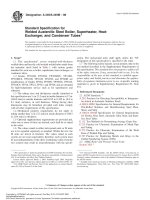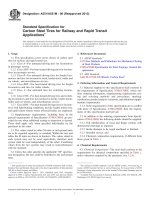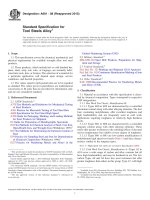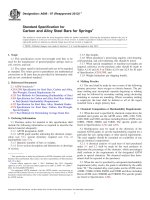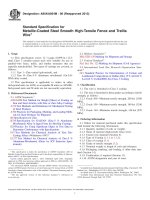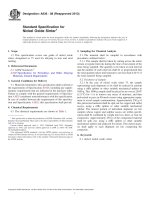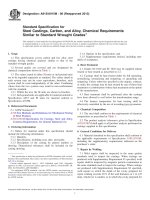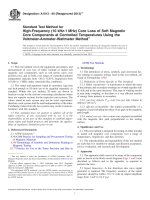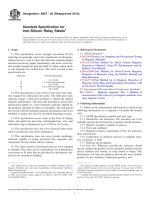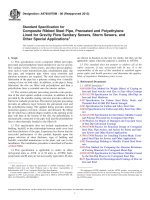Astm a 809 08 (2013)
Bạn đang xem bản rút gọn của tài liệu. Xem và tải ngay bản đầy đủ của tài liệu tại đây (78.06 KB, 3 trang )
Designation: A809 − 08 (Reapproved 2013)
Standard Specification for
Aluminum-Coated (Aluminized) Carbon Steel Wire1
This standard is issued under the fixed designation A809; the number immediately following the designation indicates the year of
original adoption or, in the case of revision, the year of last revision. A number in parentheses indicates the year of last reapproval. A
superscript epsilon (´) indicates an editorial change since the last revision or reapproval.
This standard has been approved for use by agencies of the Department of Defense.
nickel, titanium, tungsten, vanadium, or zirconium or any other
element is added to obtain a desired alloying effect; (2) when
the specified minimum copper content does not exceed 0.40 %;
or ( 3) when the maximum specified content for any of the
following elements does not exceed these percentages: manganese 1.65, silicon 0.60, or copper 0.60.
3.1.2 aluminum-coated (aluminized) wire—aluminumcoated (aluminized) wire is produced by passing individual
wires through a bath of molten aluminum, after first being
properly preheated, cleaned, and pickled.
3.1.3 temper—as applied to aluminum-coated (aluminized)
wire, pertains to stiffness or resistance to bending. It has
customarily been expressed by tensile strength as shown in the
three ranges given in Table 1. The temper of a given chemical
composition can be controlled by the use of a different thermal
treatment for each temper. Different properties can also be
obtained by varying the chemical composition for a given
thermal treatment. A thorough understanding of the end use of
the wire, which involves both tensile strength and ductility,
should be reached between the user and the manufacturer of the
aluminum-coated (aluminized) wire. Requirements for both
chemical composition and mechanical properties may be
technologically impracticable.
1. Scope
1.1 This specification covers soft, medium, and hard temper
carbon steel wire coated with aluminum by a hot-dip process,
supplied in coils for general use.
1.2 The values stated in inch-pound units are to be regarded
as standard. The values given in parentheses are mathematical
conversions to SI units that are provided for information only
and are not considered standard.
2. Referenced Documents
2.1 ASTM Standards:2
A370 Test Methods and Definitions for Mechanical Testing
of Steel Products
A428/A428M Test Method for Weight [Mass] of Coating on
Aluminum-Coated Iron or Steel Articles
A700 Practices for Packaging, Marking, and Loading Methods for Steel Products for Shipment
E29 Practice for Using Significant Digits in Test Data to
Determine Conformance with Specifications
2.2 U.S. Military Standards:3
MIL-STD-129 Marking for Shipment and Storage
MIL-STD-1188 Commercial Packaging of Supplies and
Equipment
2.3 U.S. Federal Standard:
Fed. Std. No. 123 Marking for Shipment (Civil Agencies)3
4. Ordering Information
4.1 Orders for material under this specification should
include the following information:
4.1.1 Quantity (weight in pounds (kilograms)),
4.1.2 Coated wire diameter, expressed to 0.001 in. (0.025
mm),
4.1.3 Name of material (aluminum-coated carbon steel
wire),
4.1.4 Temper (soft, medium, or hard) (Table 1),
4.1.5 Packaging requirements, and
4.1.6 ASTM designation and year of issue.
3. Terminology
3.1 Definitions of Terms Specific to This Standard:
3.1.1 carbon steel—steel is considered to be carbon steel (1)
when no minimum content is specified or required for
aluminum, chromium, cobalt, columbium, molybdenum,
1
This specification is under the jurisdiction of ASTM Committee A05 on
Metallic-Coated Iron and Steel Products and is the direct responsibility of Subcommittee A05.12 on Wire Specifications.
Current edition approved April 1, 2013. Published April 2013. Originally
approved in 1983. Last previous edition approved in 2008 as A809 – 08. DOI:
10.1520/A0809-08R13.
2
For referenced ASTM standards, visit the ASTM website, www.astm.org, or
contact ASTM Customer Service at For Annual Book of ASTM
Standards volume information, refer to the standard’s Document Summary page on
the ASTM website.
3
Available from Standardization Documents Order Desk, Bldg. 4, Section D,
700 Robbins Ave., Philadelphia, PA 19111-5094, Attn: NPODS.
NOTE 1—A typical ordering description is as follows: 40 000 lb,
0.148-in. aluminum-coated carbon steel wire, medium temper, in 500- to
600-lb catch-weight coils on tubular carriers to ASTM A809–88.
5. Materials and Manufacture
5.1 The steel rod from which the wire is produced shall be
manufactured by any commercially accepted steel making
practice.
*A Summary of Changes section appears at the end of this standard
Copyright © ASTM International, 100 Barr Harbor Drive, PO Box C700, West Conshohocken, PA 19428-2959. United States
1
A809 − 08 (2013)
TABLE 1 Tensile Strength for Temper Designation
Wire Diameter, in.
(mm)
0.080 to under 0.106
(2.03 to 2.69)
0.106 to 0.176, incl
(2.69 to 4.47)
Over 0.176
(over 4.47)
A428M, shall have a minimum weight of aluminum coating in
accordance with Table 2.
Tensile Strength, ksi (MPa)A
Soft Temper
Medium Temper
75 max
(515 max)
70 max
(485 max)
70 max
(485 max)
70
(485
65
(450
60
(415
to
to
to
to
to
to
95
655)
90
620)
85
585)
Hard Temper
9. Adherence of Coating
9.1 The aluminum-coated wire as represented by the test
specimens shall be capable of being wrapped in a close helix at
a rate not exceeding 15 turns/min around a cylindrical steel
mandrel having a diameter equal to three times the nominal
diameter of the coated wire under test, without cracking or
flaking the aluminum coating to such an extent that any
aluminum can be removed by rubbing with the bare fingers.
85 to 115
(585 to 795)
80 to 110
(550 to 760)
75 to 105
(515 to 725)
A
For the purpose of determining conformance with this specification, an observed
value shall be rounded to the nearest 1 ksi in accordance with the rounding method
of Practice E29.
9.2 Loosening or detachment during the adhesion test of
superficial, small particles of aluminum formed by mechanical
polishing of the surface of the aluminum-coated wire shall not
be considered cause for rejection.
5.2 The ingot or pig aluminum used for coating shall
conform to the following impurity limits:
10. Workmanship
max, %
0.10
0.50
Copper
Iron
10.1 The aluminum-coated wire shall be free of slivers,
scale, and other imperfections not consistent with good commercial practice. The coating shall be continuous and reasonably uniform. To ensure large continuous length coils, welds
may be present in the finished wire.
6. Mechanical Properties
6.1 The aluminum-coated wire shall meet the tensile
strength in accordance with Table 1 when tested in accordance
with Test Methods and Definitions A370.
11. Number of Tests and Retests
6.2 Test specimens containing a weld or an obvious defect
shall be discarded and another test specimen obtained to verify
conformance to the tensile strength requirements.
11.1 A lot shall consist of all of the coils of wire of the same
size, type and class, and shall be offered for inspection at one
time. A wire sample of sufficient length, approximately 4 ft.
(1.2 m), shall be cut from either end of each coil selected for
tests described in Sections 6, 8, and 9.
7. Dimensions and Tolerances
7.1 The permissible variation in diameter of the aluminumcoated wire as represented by the test specimens shall be in
accordance with Table 2.
11.2 The number of test specimens taken from the ends of
coils during production to assure compliance with Sections 6
and 7 varies with the quality control procedures and the
manufacturing facilities of each manufacturer, but is generally
not less than 10 % of the coils produced. For the purpose of
final product testing, one specimen from every ten coils or
fraction thereof in a lot shall be selected at random, or a total
of seven specimens, whichever is less.
8. Weight of Coating
8.1 The aluminum-coated wire as represented by the test
specimens tested in accordance with Test Method A428/
TABLE 2 Dimensions, Tolerances, and Minimum Weight of
Aluminum Coating per Unit Area of Uncoated Wire Surface
Specified Wire Diameter, in.
(mm)A
0.080 to under 0.092
(2.03 to under 2.34)
0.092 to under 0.106
(2.34 to under 2.69)
0.106 to under 0.148
(2.69 to under 3.76)
0.148 to under 0.244
(3.76 to under 6.20)
0.244
(6.20)
Tolerance, ±in. (mm)B
Minimum
Weight of Aluminum
Coating, oz/ft2 (g/m2)
0.004 (0.10)
0.30 (92)
0.004 (0.10)
0.32 (98)
0.004 (0.10)
0.35 (107)
0.004 (0.10)
0.40 (122)
0.005 (0.13)
0.40 (122)
11.3 Should one or more of the wire specimens fail any
requirement, the lot shall be subjected to retest. For retest
purposes the original lot shall be regrouped into 50 coil lots or
fractions thereof. Each lot shall be tested for the property in
which the original sample failed to comply at a frequency of
10 % or more so that the total number of tests is at least double
the original. Any lot that exhibits a failure shall be rejected. If
during retesting an additional quality parameter is observed to
be defective, the lot of 50 is subject to rejection for that cause.
The manufacturer may test each coil in the failed lot for the
property in which failure occurred and reject only the nonconforming coils.
A
For the purpose of determining conformance with this specification, an observed
value shall be rounded to the nearest 0.001 in., in accordance with the rounding
method of Practice E29.
B
It is recognized that the surfaces of heavy aluminum coatings, particularly those
produced by the hot dip process, are not perfectly smooth. If the tolerances shown
in this table are rigidly applied to such irregularities that are inherent to the product,
unjustified rejections of wire that would actually be satisfactory for use could occur.
Therefore, it is intended that these tolerances be used in gaging the uniform areas
of the aluminized wire.
12. Inspection
12.1 Unless otherwise specified in the contract or purchase
order, the manufacturer is responsible for the performance of
all inspection and test requirements specified in this specification. Except as otherwise specified in the contract or purchase
order, the manufacturer may use his own or any other suitable
facilities for the performance of the inspection and test
2
A809 − 08 (2013)
requirements, unless disapproved by the purchaser at the time
the order is placed. The purchaser shall have the right to
perform any of the inspections and tests set forth in this
specification when such inspections and tests are deemed
necessary to assure that the material conforms to prescribed
requirements.
14.2 Packaging of the coils of wire shall be by agreement
between the producer and the purchaser. This agreement shall
include coil dimensions and mass.
14.3 Unless otherwise specified, the packaging, marking,
and loading shall be in accordance with Practices A700.
14.4 For procurement by or direct shipment to the U.S.
Government, marking for shipment, in addition to the requirements specified in the contract or order, shall be in accordance
with MIL-STD-129 for military agencies and with Fed. Std.
No. 123 for civil agencies.
13. Rejection and Rehearing
13.1 Material that fails to conform to the requirements of
this specification may be rejected. Rejections should be reported to the producer or supplier promptly and in writing. In
case of dissatisfaction with the results of the test, the producer
or supplier may make claim for a rehearing.
13.2 The material must be adequately protected and correctly identified in order that the producer or supplier may
make a proper investigation.
14.5 When specified in the contract or order, and for direct
procurement by or direct shipment to the U.S. Government,
commercial packaging shall be in accordance with MIL-STD1188.
14. Packaging, Marking, and Loading
15. Keywords
14.1 Marking shall be by a tag securely attached to each coil
of wire and shall show the identity of the producer, name of
product, temper, and ASTM designation.
15.1 aluminized wire; aluminum-coated carbon steel wire;
steel wire; wire
ASTM International takes no position respecting the validity of any patent rights asserted in connection with any item mentioned
in this standard. Users of this standard are expressly advised that determination of the validity of any such patent rights, and the risk
of infringement of such rights, are entirely their own responsibility.
This standard is subject to revision at any time by the responsible technical committee and must be reviewed every five years and
if not revised, either reapproved or withdrawn. Your comments are invited either for revision of this standard or for additional standards
and should be addressed to ASTM International Headquarters. Your comments will receive careful consideration at a meeting of the
responsible technical committee, which you may attend. If you feel that your comments have not received a fair hearing you should
make your views known to the ASTM Committee on Standards, at the address shown below.
This standard is copyrighted by ASTM International, 100 Barr Harbor Drive, PO Box C700, West Conshohocken, PA 19428-2959,
United States. Individual reprints (single or multiple copies) of this standard may be obtained by contacting ASTM at the above
address or at 610-832-9585 (phone), 610-832-9555 (fax), or (e-mail); or through the ASTM website
(www.astm.org). Permission rights to photocopy the standard may also be secured from the ASTM website (www.astm.org/
COPYRIGHT/).
3
